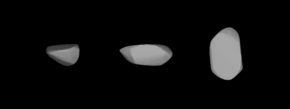|
302 Clarissa
302 Clarissa is a typical main belt asteroid.[1] The asteroid was discovered by the French astronomer Auguste Charlois on 14 November 1890 in Nice. The origin of the name is unknown.[3] In 1991, 302 Clarissa was being considered as a possible fly-by target for the Cassini spacecraft, but was later removed from consideration.[4] This body is orbiting the Sun with a period of 3.73 years and an eccentricity (ovalness) of 0.11. The orbital plane is inclined by 3.4° to the plane of the ecliptic. There are no major planetary resonances near the orbit of 302 Clarissa. It has a retrograde spin with a rotation period of 14.4797 hours. Stellar occultation data provides a size estimate of 43±4 km,[2] while IRAS data gives a diameter of 38.5±3.1 km. It is classified as a F-type asteroid and is probably composed of carbonaceous material.[1] 302 Clarissa provides the eponym for a small collisional asteroid family of mostly C-type asteroids. This group consists of 179 bodies with orbits clustered around 302 Clarissa. The family has a small extend of semimajor axis values, suggesting this is a young group; its estimated age is 56±5 Myr. 70–90% of the objects in this family have a retrograde spin, suggesting the parent body may have possessed a similar rotation.[2] This family is one of five that are candidate sources for the near Earth asteroids 101955 Bennu and 162173 Ryugu.[5] Spacecraft visitsAt present, Clarissa has not been visited by any spacecraft. As of 1991, mission planning for the Cassini–Huygens spacecraft included a flyby (spaceflight) of Clarissa while leaving the inner solar system in November 1998,[6] however due to delays, the launch of Cassini-Huygens was moved from November 1995 to October 1997, thus negating the option to pass near Clarissa. Cassini-Huygens passed by asteroid 2685 Masursky on 23 January 2000 instead. References
External links
|
||||||||||||||||||||||||||||||||||||||||||||||||||||||||||||
Portal di Ensiklopedia Dunia
